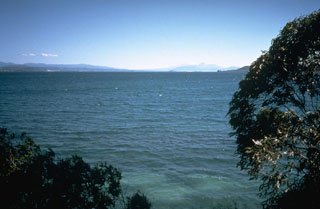Report on Taupo (New Zealand) — 30 November-6 December 2022
Smithsonian Institution / US Geological Survey
Weekly Volcanic Activity Report, 30 November-6 December 2022
Managing Editor: Sally Sennert.
Please cite this report as:
Global Volcanism Program, 2022. Report on Taupo (New Zealand) (Sennert, S, ed.). Weekly Volcanic Activity Report, 30 November-6 December 2022. Smithsonian Institution and US Geological Survey.
Taupo
New Zealand
38.7811°S, 175.893°E; summit elev. 760 m
All times are local (unless otherwise noted)
GeoNet reported that a strong M 5.6 [later revised to 5.7] earthquake occurred beneath Taupo on 30 November. The event was widely felt and caused a small tsunami in the lake. Lake water inundated the shore at several locations, mostly along the N shore, traveling inland as far as 40 m at Wharewaka Point (along the NE shore). Both the earthquake and the tsunami caused minor local damage. The instrument at Horomatangi recorded 250 mm of horizontal ground movement towards the SE, the largest movement ever recorded at that location. Other onshore stations recorded smaller movements of around 10-20 mm. More than 600 aftershocks were located by 7 December, though the magnitude and rate of the events had begun to decline. The largest aftershock was an M 4.5 and two other M 4 events were also recorded.
Earthquakes larger than M 5 beneath Lake Taupo had occurred only four times since 1952, including a M 5 event that occurred on 4 September 2019 as part of a previous period of volcanic unrest. GeoNet noted that there had been 17 previous episodes of unrest at Taupo over the previous 150 years, some more notable than the current episode, and many others before written records. None resulted in an eruption, with the last eruption occurring around 232 CE. The Volcanic Alert Level remained at 1 (the second lowest level on a six-level scale) and the Aviation Color Code remained at Green (the lowest level on a four-color scale).
Geological Summary. Taupo, the most active rhyolitic volcano of the Taupo volcanic zone, is a large, roughly 35-km-wide caldera with poorly defined margins. It is a type example of an "inverse volcano" that slopes inward towards the most recent vent location. The caldera, now filled by Lake Taupo, largely formed as a result of the voluminous eruption of the Oruanui Tephra about 22,600 years before present (BP). This was the largest known eruption at Taupo, producing about 1,170 km3 of tephra. This eruption was preceded during the late Pleistocene by the eruption of a large number of rhyolitic lava domes north of Lake Taupo. Large explosive eruptions have occurred frequently during the Holocene from many vents within Lake Taupo and near its margins. The most recent major eruption took place about 1,800 years BP from at least three vents along a NE-SW-trending fissure centered on the Horomotangi Reefs. This extremely violent eruption was New Zealand's largest during the Holocene and produced the thin but widespread phreatoplinian Taupo Ignimbrite, which covered 20,000 km2 of North Island.
Source: GeoNet

